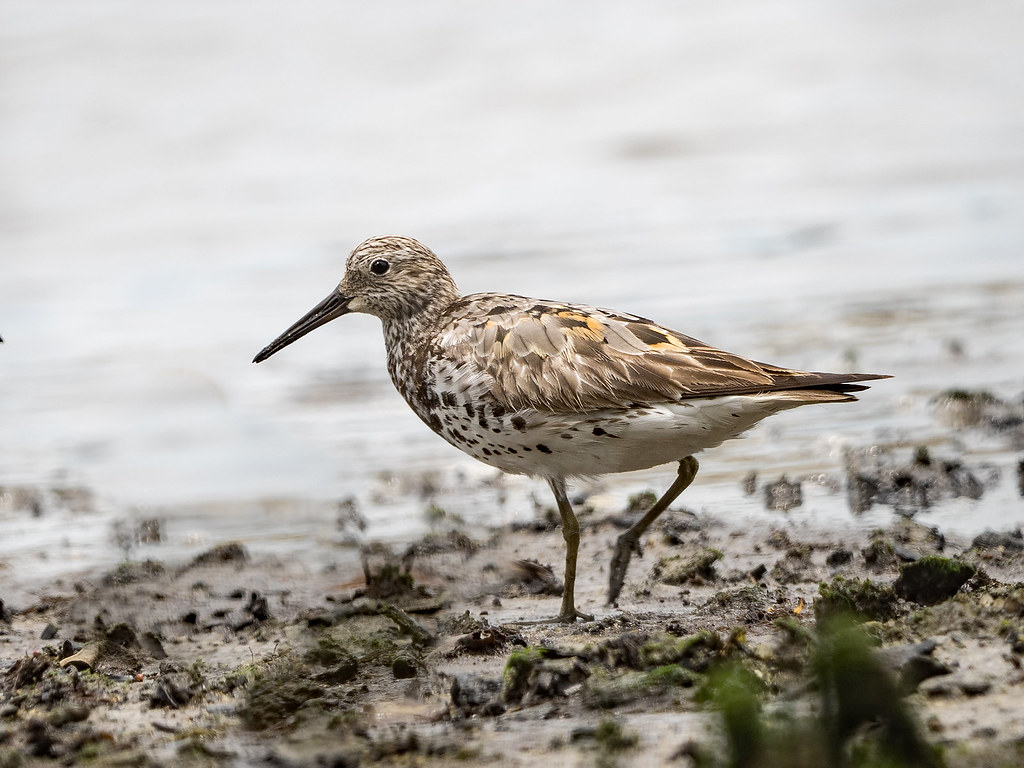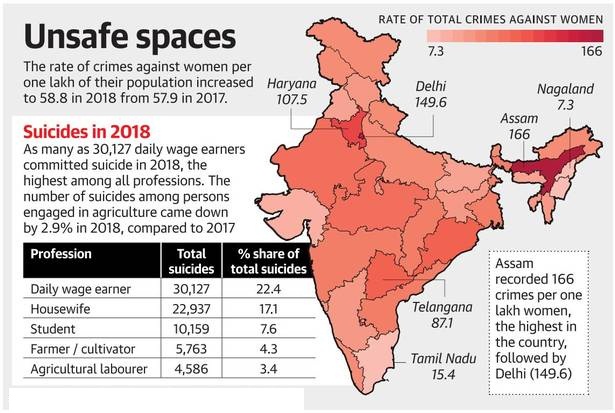Governance
Annual Crimes in India Report 2018: NCRB
Why in News
The National Crime Records Bureau (NCRB) published the annual Crime in India Report 2018. It shows the crime statistics in the country between 2017 and 2018.
- NCRB has also released Accidental Death and Suicides in India 2018 report which outlines death and suicide statistics of the country.
Key Points
- The report shows an increase of 1.3% in the registration of cases.
- The crime rate per lakh population has come down from 388.6 in 2017 to 383.5.
- Crime Against Women: The rise has been observed in 2018 compared to 2017.
- Uttar Pradesh topped the list followed by Maharashtra and West Bengal.
- Delhi tops the list among the metropolitan cities.
- Cruelty by husband or his relatives (31.9%) followed by an assault on women with intent to outrage her modesty (27.6%) constituted the major share of crimes against women.
- Suicides: The total number of people who committed suicide in 2018 has increased from 2017.
- The highest number of suicide victims were daily wage earners comprising 22.4% of such deaths.
- Maximum of the suicides were reported from Maharashtra followed by Tamil Nadu, West Bengal, Madhya Pradesh and Karnataka.
- Farm sector workers accounted for 7.7 % of the total number of suicides in the country.
- West Bengal, Bihar, Odisha, Uttarakhand, Meghalaya, Goa, Chandigarh, Daman & Diu, Delhi, Lakshadweep and Puducherry reported zero suicides by farmers/cultivators and agricultural labourers.
- Economic Offences: It includes criminal breach of trust, forgery, cheating, fraud and counterfeiting, etc. Higher economic offences were observed in 2018 as compared to 2017.
- Uttar Pradesh accounted for the maximum number of economic offences followed by Telangana and Bihar.
- Violence due to Riots: Riot cases due to communal, political, agrarian and student issues declined but riots arising out of industrial and water disputes rose sharply.
- SC/ST related crimes: The incidents registered under the Scheduled Caste and Scheduled Tribes related Acts observed a decline in 2018 from 2017.
- Cyber Crimes: An increase in cybercrimes has been observed in 2018 compared to 2017.
Indian Polity
Curative Petition
Why in News
Recently the two Nirbhaya case convicts have filed Curative petitions in the Supreme Court.
- Earlier, the convicts had filed a mercy petition and review petition which has been rejected.
Key Points
- Origin:
- The concept of the curative petition was first evolved by the Supreme Court of India in Rupa Ashok Hurra vs. Ashok Hurra and another case (2002) on the question whether an aggrieved person is entitled to any relief against the final judgement/order of the Supreme Court, even after the dismissal of a review petition.
- Objectives:
- It’s objectives are twofolds- avoid miscarriage of justice and to prevent abuse of process.
- Constitutional Background:
- The concept of the curative petition is supported by Article 137 of the Indian Constitution. It provides that in the matter of laws and rules made under Article 145, the Supreme Court has the power to review any judgement pronounced (or order made) by it. Such a petition needs to be filed within 30 days from the date of judgement or order.
- Procedure:
- A curative petition may be filed after a review plea against the final conviction is dismissed.
- It can be entertained if the petitioner establishes that there was a violation of the principles of natural justice, and that he was not heard by the court before passing an order.
- It must be rare rather than regular.
- A curative petition must be first circulated to a Bench of the three senior-most judges, and the judges who passed the concerned judgment, if available. Only when a majority of the judges conclude that the matter needs hearing should it be listed before the same Bench.
- The Bench at any stage of consideration of the curative petition can ask a senior counsel to assist it as amicus curiae (Friend of the court).
- A curative petition is usually decided by judges in the chamber unless a specific request for an open-court hearing is allowed.
- Grounds for Rejection:
- In the event of the Bench holding at any stage that the petition is without any merit, it may impose a penalty on the petitioner.
Biodiversity & Environment
Panel Approves Scheme to Trade in Forests
Why in News
Recently, the Forest Advisory Committee (FAC) has approved the Green Credit Scheme. It will allow the Forest Department to outsource the responsibility of reforesting to non-government agencies, if implemented.
- Currently, in the case of the loss of forest, the industry needs to find appropriate non-forest land and pay Net Present Value (current economic equivalent) to the State Forest Department. Then it is the Forest Department’s responsibility to grow appropriate vegetation which would grow into forests over time.
Key Points
- Green Credit Scheme allows agencies (private companies, village forest communities etc.) to identify land and grow plantations. After three years, the land would be eligible to be considered as compensatory forest land if it meets the criteria set by the Forest Department. An industry needing forest land could then approach the agency and pay it for parcels of such forested land and this would then be transferred to the Forest Department and be recorded as forest land. In simpler words, it will allow forests to be traded as a commodity.
- This scheme will encourage plantation by individuals outside the traditional forest area and will help in meeting international commitments such as Sustainable Development Goals and Nationally Determined Contributions.
- It will also help in solving various industries’ complain that they find it hard to acquire appropriate non-forest land, which has to be contiguous to existing forest.
- The scheme will also supplement the Green India Mission, which is one of India’s initiatives to combat climate change.
- It aims to sequester 2.523 billion tonnes of carbon by 2020-30 and this involves adding 30 million hectares in addition to an existing forest.
- However, it does not solve the core problems of compensatory afforestation and creates problems of privatising multi-use forest areas as monoculture plantation plots.
- Earlier in 2015, a ‘Green Credit Scheme’ for degraded forest land with public-private participation was recommended but it was not approved.
Forest Advisory Committee
- It is a statutory body which was constituted by the Forest (Conservation) Act 1980.
- It comes under the Ministry of Environment, Forests & Climate Change (MoEF&CC).
- It considers questions on the diversion of forest land for non-forest uses such as mining, industrial projects, townships and advises the government on the issue of granting forest clearances. However, its role is advisory.
Biodiversity & Environment
Miyawaki Method in Kerala
Why in news?
Kerala has decided to use the Japanese Miyawaki method of afforestation.
- Earlier, Tamil Nadu, Maharashtra, Telangana and some other states adopted this method.
- The replication of the model across Kerala, which has suffered floods, landslides and soil erosion, assumes significance with the Rebuild Kerala initiative on.
Key Points
- The Miyawaki method has revolutionised the concept of urban afforestation by turning backyards into mini-forests.
- Regardless of soil and climatic conditions it has helped create more than 3,000 forests all over the world.
- It creates a dense forest in just 20 to 30 years, while through conventional methods it takes anywhere between 200 to 300 years.
- Forests grow 10 times faster and 30 times denser.
- The saplings become self-sustainable after the first three years.
Miyawaki Process
- The native trees of the region are identified and divided into four layers — shrub, sub-tree, tree, and canopy.
- The quality of soil is analysed and biomass which would help enhance the perforation capacity, water retention capacity, and nutrients in it, is mixed with it.
- A mound is built with the soil and the seeds are planted at a very high density. The ground is covered with a thick layer of mulch.
- Multi-layered saplings are planted close to each other. This blocks sunlight from reaching the ground and prevents weeds from growing, thus keeping the soil moist. The close cropping further ensures that the plants receive sunlight only from the top thus enabling them to grow upwards rather than sideways.
- This is one of the reasons why the saplings grow tall in a short span of time.
Concerns
- Such forests lack some qualities of natural forests, such as medicinal properties and the ability to bring rain.
- Such fast-growing plantations are actually wood lots (a parcel of a woodland or forest capable of small-scale production of forest products (such as wood fuel, sap for maple syrup, sawlogs, and pulpwood) and cannot be termed as forests.
- Several environmentalists have questioned the efficacy of the method that accelerates the growth of trees and claims to match a forest’s complex ecosystem (as it is not a good idea to force plants to photosynthesize fast).
- Environmentalists also pointed out that the technique was started by the Japanese considering the climate in Japan and the regular occurrence of natural calamities like earthquakes. But, the method is not good for a tropical country like India.
Biodiversity & Environment
Demand for Declaration of Goa Sanctuaries as Tiger Reserve
Why in News
Activists and politicians from Goa have demanded that certain areas in wildlife sanctuaries of the state be notified as a tiger reserve.
- In 2017, the State government had proposed about 500 sq km area of Mahadayi, Netravali and Cotigao sanctuaries with some part of Bhagwan Mahaveer wildlife sanctuary to be marked as a tiger reserve.
- Recent deaths of four tigers in Mahadayi wildlife sanctuary has brought the demand again in the scenario.
Netravali Wildlife Sanctuary
- Netravali Wildlife Sanctuary is located in Goa bounded by Cotigao wildlife sanctuary on the eastern side and Bhagwan Mahaveer wildlife sanctuary on the northern side.
- It is predominantly moist deciduous forests with patches of semi-evergreen forest in the valleys.
- It has two important waterfalls namely, Savari and Mainapi.
- This region supports a rich diversity of flora and fauna and notable among them are Leopard, Giant Squirrel, Mouse Deer, Nilgiri Wood Pigeon and Ceylon Frogmouth.
Cotigao Wildlife Sanctuary
- Cotigao Sanctuary is situated in Canacona Taluka, of Goa.
- It was established in 1968-69 to protect a remote and vulnerable area of forest lining the Goa- Karnataka border.
- The vegetation is mostly moist-deciduous type, interspersed with semi-evergreen and evergreen patches.
Bhagwan Mahaveer Wildlife Sanctuary
- Bhagwan Mahaveer Wildlife Sanctuary is located in the Mollem town of Goa.
- It is one of the largest wildlife sanctuaries of Goa and contains within it the Mollem National Park.
- It was formed to protect the vast biodiversity of the Western Ghat.
- Originally known as the Mollem Game Sanctuary, it was declared a wildlife sanctuary in 1969 and thence renamed the Bhagwan Mahavir Wildlife Sanctuary.
- The sanctuary is heavily forested and contains tropical evergreen forests, semi-evergreen forests and moist deciduous forests.
Indian Polity
States’ Prerogative to Provide 10% Reservation
Why in News
Recently, the Centre informed the Supreme Court that it would be the States’ prerogative to provide 10% economic reservation in government jobs and admission to educational institutions.
- The State governments concerned are to decide whether or not to provide reservation to the Economically Weaker Section (EWS) in appointment to State government jobs and admission to State government educational institutions, as per provisions of the newly inserted Articles 15(6) and 16(6) by the Constitution 103rd Amendment Act, 2019.
Key Points
- This comes as a response to a Public Interest Litigation (PIL) that seeks the Supreme Court’s intervention to implement the 10% EWS quota in Tamil Nadu and Karnataka without disrupting the existing reservation framework, which covers the Scheduled Castes (SC), Scheduled Tribes (ST), Backward Classes (BC) and Most Backward Classes (MBC).
- The 10% reservation prescribed by the Amendment Act is in addition to the existing reservation. It nowhere affects or infringes anybody’s fundamental rights to equality instead gives rights of equal participation and representation to the EWS.
- Centre informed the Supreme Court that it has no role in deciding the reservation policy of any state government. The concerned state governments have to decide the reservation under Articles 15(6) and 16(6).
Background
- In 2019, SC issued a notice to the Centre on a PIL seeking direction to Karnataka and Tamil Nadu to implement 10% quota in jobs and education for EWS as per the mandate of the 103rd Constitutional (Amendment) Act, 2019.
- The petition contended that neither Tamil Nadu nor Karnataka had implemented this amendment.
- It also highlighted that Tamil Nadu reserves 69% of its jobs and education seats for SCs, STs, BCs and MBCs, while the number stands at 70% in Karnataka.
Constitution (103rd Amendment) Act, 2019
- It introduced economic reservation by amending Articles 15 and 16. It inserted Article 15 (6) and Article 16 (6) in the Constitution to allow reservation for the economically backward in the unreserved category.
- It was enacted to promote the welfare of the poor not covered by the 50% reservation policy for SCs, STs and Socially and Educationally Backward Classes (SEBC).
- It enables both Centre and the states to provide reservation to the EWSs of society.
- Since this is a central law on subjects (employment, education) in the concurrent list (subjects on which states and the central government both have jurisdiction), the state governments need to ratify it before adopting it locally.
Science & Technology
Important Facts For Prelims
Nalabana Bird Sanctuary
Why in News
Recently, a record number of migratory birds have arrived at the Nalabana bird sanctuary in Odisha.
- The dismantling of illegal prawn gherries inside the lake is being cited as the main reason behind the avian gathering. Gherries are areas encroached for illegal prawn cultivation inside the wetland area.
Key Points
- The Nalabana bird sanctuary is located on Nalabana Island in the Chilika lagoon area in Odisha.
- The Nalabana Bird Sanctuary is the core area of Chilika.
- The large Nalabana Island (Forest of Reeds) covering about 16 sq km was declared a bird sanctuary in 1987.
- The island disappears during the monsoon due to inundation, only to emerge again post-monsoon.
- Nalabana and Mangalajodi (on the banks of Chilika lake) are the two major places in Chilika where the birds congregate.
- Migratory birds usually start arriving at Chilika in November as it is a comparatively hospitable alternate habitat compared to the extreme freezing conditions in their natural habitats in Siberia, China, Japan and other countries in the northern hemisphere.
- Few important migratory birds seen here are: Bar-headed geese, greater flamingos, herons, black-tailed godwits and rare Great Knot. The Great Knot was seen after five years.
- Chilika Lake is Asia's largest and world's second-largest lagoon after the New Caledonian barrier reef in New Caledonia.
Great Knot (Calidris tenuirostris)
- The Great Knot is an international migratory bird that travels vast distances between the northern hemisphere breeding grounds and southern hemisphere summer feeding grounds around.
- It is distributed in far northeast Russia, coastal Australia, southeast Asia, India, Bangladesh, Pakistan and eastern Arabian Peninsula.
- It is listed as Endangered under the International Union for Conservation of Nature (IUCN) Red List.
Important Facts For Prelims
Army’s GOCO Model for Improving Efficiency
Why in News
Recently, the Indian Army has initiated the process of identifying potential industry partners to implement the Government Owned Contractor Operated (GOCO) model for its base workshops and ordnance depots.
- GOCO will improve the operational efficiency of the army.
Key Points
- The army issued a Request For Information (RFI) to shortlist service providers with experience in warehousing, logistics and supply chain management.
- Criteria for Service Provider: It should be an Indian registered company with at least 10 years of working experience in related domains and have an average annual turnover of ₹50 crore for each of the last three financial years.
Government Owned Contractor Operated Model
- It was one of the recommendations of the Lt. Gen. DB Shekatkar (Retd.) committee to enhance combat capability and re-balancing defence expenditure.
- In GOCO model, the assets owned by government is operated by the private industries.
- The private players are given full autonomy in implementing the vision set by the government, using their best practices.
- The main advantage of the model is that it is efficient and will boost competitiveness among the private entities.







